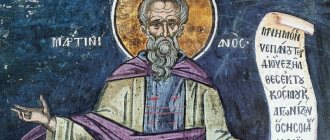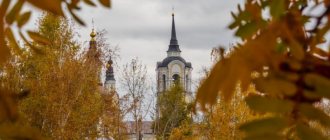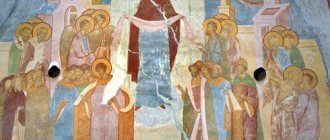Moscow, 07/24/2021, 05:04:20, editorial office of FTimes.ru, author Tatyana Orlonskaya.
On the calendar it is Wednesday, day 296 of 2021 according to the Gregorian calendar. October 23 corresponds to October 10 of the Julian calendar (old style). What church holiday do the Orthodox honor today? Read on.
In the church calendar, this is the date of veneration of two holy martyrs - brother and sister Evlampios and Eulampia. Today is a one-day fast, and it will also be repeated on October 25 and 30. These days you should refrain from eating eggs, meat and dairy products.
Folk signs on October 23
- On this day, the horns of the month point to the side where the winds come from. If the horns of the month are to the north, there will be a quick and severe winter, the snow will fall dry; if to the south, don’t expect a quick winter, there will be mud and slush until November 4th.
- If there is slush and dirt on the street on this day, it means that snow will not fall until November 4th.
- If there is no frost on this day, don’t wait for 4 weeks for winter.
- If the western sky is clear during the day, there will be no rain.
- If in bad weather the southwest wind changes its direction to the northeast or north or intensifies, the rain will soon stop.
- Willow leaves on the upper branches remain green for a long time, while those below have long fallen off - for early winter and a fertile spring.
- On large rivers the water may already freeze.
- The last cumulus clouds are floating across the sky.
- Old things were burned, which were supposed to take away all the bad things.
- Wanting to be cleansed of adversity and illness, it was customary to jump over a fire, which was supposed to revive a new life and prolong youth.
Venerable Ambrose of Optina
The church honors the memory of Saint Ambrose, the elder of Optina Hermitage (birth name - Alexander Grenkov). He suffered a serious illness. He was engaged in publishing activities. He is the founder of the women's monastery in Shamordin.
The future great Optina elder Hieroschemamonk Ambrose was born on December 4, 1812 in the village of Bolshaya Lipovitsa, Tambov province, into the large family of sexton Mikhail Fedorovich Grenkov and his wife Marfa Nikolaevna. At the age of 12, Sasha (that was his name) was sent to the first grade of the Tambov Theological School, after which in 1830 he entered the Tambov Theological Seminary. Six years later, his studies were successfully completed, but Alexander did not enter the theological academy. He did not become a priest either. For some time he was a home teacher in a landowner family, and then a teacher at the Lipetsk Theological School.
At the age of 27, tormented by reproaches of conscience about the unfulfilled vow he made to God in the last class of the seminary - to become a monk if he recovered from a serious illness - Alexander Mikhailovich secretly, without even asking permission from the diocesan authorities, fled to Optina Pustyn, which was then “a pillar of fire in the darkness of the surrounding night, which attracted to itself all the little ones seeking light.”
According to legend, this monastery, located three miles from the city of Kozelsk and surrounded on three sides by impenetrable virgin forests and on the fourth by the Zhizdra River, was founded by a repentant robber named Opta, an associate of Ataman Kudeyar. The life of the monastery was based on strict observance of three rules: strict monastic life, preservation of poverty and the desire to always and in everything carry out the truth, in the complete absence of any partiality. The monks were great ascetics and prayer books for Orthodox Rus'. During his lifetime, Alexander Mikhailovich saw, one might say, the very flower of her monasticism, such pillars as Abbot Moses, elders Leo and Macarius.
In April 1840, almost a year after his arrival, Alexander Mikhailovich Grenkov became a monk. He was actively involved in the everyday life of the monastery: he brewed yeast, baked rolls, and was an assistant cook for a whole year. Two years later he was tonsured and named Ambrose. After five years of living in Optina Pustyn in 1845, 33-year-old Ambrose already became a hieromonk.
His health deteriorated greatly during these years, and in 1846 he was forced to leave the state, being unable to fulfill obediences, and became a dependent of the monastery. Soon the state of his health became threatening, the end was expected, and according to ancient Russian custom, Father Ambrose was tonsured into the schema. But the ways of the Lord are inscrutable: two years later, unexpectedly for many, the patient began to recover. As he himself later said:
“In a monastery, those who are sick do not die quickly until the illness brings them real benefit.”
During these years, the Lord raised the spirit of the future great elder not only through physical infirmities. Particularly important for him was communication with the elders Leo and Macarius, who, seeing Ambrose as the chosen vessel of God, said about him nothing less than: “Amvrosy will be a great man.” Listening to the wise instructions of Elder Leo, he at the same time became very attached to Elder Macarius, often talked with him, opening his soul to him and receiving important advice for himself, and helped him in the publication of spiritual books. The young ascetic finally found what his soul had long thirsted for. He wrote to friends about the spiritual happiness that opened up for him in Optina Pustyn.
“Just as all the paths leading there converge at the top of a mountain, so in Optina - this spiritual peak - the highest spiritual feat of internal work and service to the world in its entirety, both its spiritual and everyday needs, converge.”
They went to the elders in Optina for consolation, healing, for advice... Those who were confused in their everyday circumstances or in philosophical quests came to them, those who thirsted for the highest truth strove there, in this “source of living water” everyone quenched their thirst. Outstanding thinkers of the era, philosophers, writers were there more than once or twice: Gogol, Alexei and Leo Tolstoy, Dostoevsky, Vladimir Solovyov, Leontyev... - you can’t count them all. After all, for a Russian person, an elder is a person sent by God Himself.
According to F. M. Dostoevsky, “for the soul of a Russian person, exhausted by work and grief, and most importantly, by everlasting injustice and everlasting sin, both one’s own and the world’s, there is no stronger need and consolation than to find a shrine or a saint, to fall before him and bow to him. If we have sin, untruth and temptation, then all the same, there is a saint and a higher one on earth somewhere - he has, but there is truth. This means that she does not die on earth, and therefore, someday she will come to us and reign over the whole earth, as promised.”
It was Ambrose who, by Divine Providence, was destined to become one of the links in the ranks of the 14 Optina elders: after the death of Elder Macarius, he took his place and for 30 years cared for suffering souls.
Elder Ambrose appeared in Optina Pustyn and attracted the attention of exclusively intelligent circles at a time when this intelligentsia was captured by Western philosophical thought. Having previously been the soul of society, who loved everything secular (he sang and danced well), for whom “the monastery was synonymous with the grave,” he understood better than anyone else the spiritual quest of the intelligentsia and with his very life testified that the path he had chosen was the ideal of that happiness that everyone should strive for.
No wonder it is said: “The power of God is made perfect in weakness.” Despite his physical suffering, which almost always confined him to bed, Elder Ambrose, who by that time already possessed a number of spiritual gifts - insight, healing, the gift of spiritual edification, etc. - received crowds of people every day and answered dozens of letters. Such gigantic work could not be accomplished by any human forces; life-giving Divine grace was clearly present here.
Among the spiritual grace-filled gifts of Elder Ambrose, which attracted many thousands of people to him, one should first of all mention his insight: he penetrated deeply into the soul of his interlocutor and read it as if in an open book, without needing his confessions. And charity was simply his need: Elder Ambrose generously distributed alms and personally took care of widows, orphans, the sick and suffering.
In the last years of the elder’s life, 12 versts from Optina Pustyn, in the village of Shamordino, with his blessing, a women’s Kazan Pustyn was established. The construction of the monastery, its rules - everything was established by Elder Ambrose himself; he personally tonsured many of the sisters of the monastery into monasticism. By the 90s of the 19th century, the number of nuns in it reached a thousand. There was also an orphanage, a school, an almshouse and a hospital.
It was in Shamordino that Elder Ambrose was destined to meet the hour of his death - in October 1891, at the 79th year of his life.
Conspiracies October 23
Amulet against dashing guests
On the day of your angel, take a knife in your right hand and, thrusting it into your threshold, say this:
Whoever comes to my house with good things, I will come to him with gold and silver. Whoever comes to me with evil, let him choke on my word. Whoever comes to rob my house will lose his mind and go into shackles. And whoever decides to kill me (so-and-so) will die, and before that He will suffer furiously. Damned forces, take all my words And walk around my hut, When you see them, grab your filthy enemies, Crush them, tear their hearts to pieces, Drink their blood, eat their brains, Yours are now my enemies From now on and forever. Nats, Abazh, Haats. Amen. Amen. Amen.
Evlampius Winter Pointer
Martyr Eulampia and Martyr Eulampia.
The memory of Saint Eulampios and his sister, who lived at the beginning of the 4th century in the city of Nicomedia. They accepted martyrdom for their faith in Christ under Emperor Maximian.
The holy martyrs Evlampios and Eulampia, brother and sister, lived at the beginning of the 4th century in the city of Nicomedia. Having read the decree of Emperor Maximian (284-305) condemning every Christian to death, Eulampius was indignant that the emperor, instead of fighting the enemies of the fatherland, was arming himself against his subjects. The young man was taken to trial and demanded to renounce the Christian faith. For his refusal, Evlampius was first tortured with iron tools and then placed on a red-hot iron bed.
Suddenly the sufferer expressed a desire to visit a pagan temple. The judges rejoiced, believing that they had broken the spirit of the young Christian. In the temple of Mars the saint exclaimed:
“In the name of the Lord Jesus Christ, I command you, dumb and soulless idol, fall to the ground and turn to dust!” The idol fell to the ground with a crash. The people shouted: “There is one Christian God, great and strong!”
The saint was again taken to torture.
At this time, the sufferer’s sister Eulampia appeared before the judges and announced that she was also a Christian. Evlampius encouraged his sister:
“Do not be afraid, sister, those who kill the body cannot kill the soul” (Matthew 10:28).
After torture, the martyrs were thrown into a red-hot furnace, but the Lord saved them from the fire. Finally, the brother was beheaded, and the sister died from agony.
Cathedral of Volyn Saints
A holiday in honor of the return of the Pochaev Lavra from the union to Orthodoxy in 1831. On this day, a cathedral celebration of the saints of the Orthodox Church in Volyn was established.
The history of the Volyn Church is rich in the abundance of holy men, glorified by the Lord Himself for high feats of faith and piety for the benefit and salvation of Russia: St. blessed Yaropolk, Prince of Vladimir-Volyn (+ 1086; November 21); Venerable Stefan of Pechersk, Bishop of Volyn (+ 1094, April 27); St. Amphilochius, Bishop of Volyn, Pechersk Wonderworker (+ 1122; October 10); Venerable Theodore, monk Theodosius, Prince of Ostrog (+ 1460; August 11), St. righteous virgin Juliana, princess from Dombrovitsa Olshanskaya (+ 1546; July 6); Venerable Job, in schema John, abbot of Pochaev (+ 1631; August 28); St. Venerable Martyr Macarius, Archimandrite of Ovruch (+ 1678; October 7). Of these saints, only one, Saint Job, rests in Volyn, in the Pochaev Lavra; and besides this, according to legend, the Monk Stefan was buried at his cathedra, in Vladimir-Volynsky.
From other St. Saint Peter, Metropolitan of Kiev-Moscow, with whose name the name of the native and abbot of Volyn has been associated since ancient times in our national history, is first of all known. The closest relative to the land of Volyn is St. Innocent, Bishop of Irkutsk, who, according to legend, descended from the ancient Volyn noble family of Kulchitsky.
In addition, here we must include St. Olga (969), who is so famous for the pacification of the Drevlyans, who, as is now known, were located within the Volyn province. This is followed by: St. Equal to the Apostles Prince Vladimir, educator of Volyn and founder of many of its cities and churches; Rev. Nikola Svyatosha, Prince of Chernigov, who in 1099 was the prince of the Lutsk appanage in Volyn, and besides this, at various times, reigned in Dorogobuzh, Peresonnitsa (Rivne district) and in other places of the ancient Volyn region. And many, many others visited the Volyn diocese either for “supervision and instruction,” or were involved in the organization of the Volyn church in troubled times.
Finally, even the holy and Equal-to-the-Apostles Slavic enlightenment brothers Cyril and Methodius were in immediate union with the land of Volyn, because history directly says that, among other countries, they also sent preachers to the Volyn region, so that as a result, according to the legends of ancient writers, the borders of the Moravian diocese of St. Methodius extended into the very depths of the Volyn land, to the Bug and Styr rivers.
Venerable Martyrs of Zograf
Memory of the abbot of the Zograf monastery Thomas and 25 other people who suffered from the raids of Latin troops during the period of resistance of the Athonite monks to the false Union of Lyons.
In 1274, at the Council of Lyon, the Byzantine Emperor Michael VIII Palaiologos decided to strengthen his power, which was close to collapse, through an alliance with Catholic Rome - a union. This step caused general discontent in the country, and the emperor in 1278 issued a decree to introduce a union in Byzantium, even if through violent measures. Holy Mount Athos firmly opposed the union. The Athonite monks sent a message to Michael, in which they thoroughly argued that the primacy of the pope, his commemoration in churches, the celebration of the Eucharist on unleavened bread, and the addition of “and from the Son” to the Creed cannot be accepted by the Orthodox, and they called on the emperor to come to his senses.
“We clearly see,” the message said, “that you are a heretic, but we beg you: leave all this and abide in the teaching that you have accepted... Reject the unholy new teachings of false knowledge, which adds guesswork to faith.”
The crusaders, expelled from Palestine and finding refuge in Romagna, declared to the emperor their readiness to assert the power of the pope with fire and sword. Mikhail also hired Turks and Tatars. When the troops approached Athos, which the emperor hated, in order not to irritate the Greeks, he decided to take out his anger on the Slavs of Athos. By order of Michael, the pope's servants attacked the Bulgarian monastery of Zograf. When the Zograf monks were asked to accept the union, none of them even wanted to hear about Catholicism.
Most of the Zografs left the monastery, and the most solid ones, 26 in number, remained in the monastery tower. These were: abbot Thomas, monks Barsanuphius, Cyril, Micah, Simon, Hilarion, Jacob, Job, Cyprian, Savva, Jacob, Martinian, Cosmas, Sergius, Mina, Joasaph, Ioannikios, Paul, Anthony, Euthymius, Dometian, Parthenius and 4 layman. The holy martyrs for the Orthodox faith were burned in the monastery tower on October 10, 1284.









